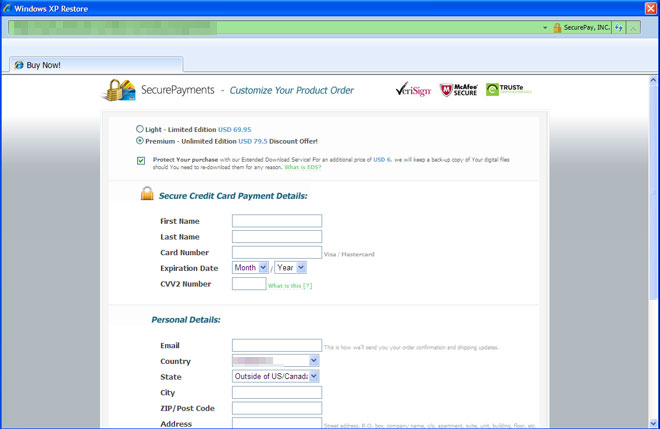TROJ_FAKEAV.UUNE
Windows 2000, XP, Server 2003


Threat Type: Trojan
Destructiveness: No
Encrypted: Yes
In the wild: Yes
OVERVIEW
This Trojan may be downloaded by other malware/grayware from remote sites.
It connects to certain URLs. It may do this to remotely inform a malicious user of its installation. It may also do this to download possibly malicious files onto the computer, which puts the computer at a greater risk of infection by other threats.
It deletes the initially executed copy of itself.
It displays fake alerts that warn users of infection. It also displays fake scanning results of the affected system. It then asks for users to purchase it once scanning is completed. If users decide to purchase the rogue product, users are directed to a certain website asking for sensitive information, such as credit card numbers. When users agree to buy the software, it connects to a certain URL.
TECHNICAL DETAILS
376,832 bytes
EXE
Yes
10 Jun 2011
Connects to URLs/IPs, Display fake alerts
Arrival Details
This Trojan may be downloaded by the following malware/grayware from remote sites:
- TROJ_FAKEAV.UUNF
It may be downloaded from the following remote sites:
- http://{BLOCKED}also.org/404.php?type=stats&affid=525&subid=01&iruns
Installation
This Trojan drops the following non-malicious files:
- %User Profile%\Application Data\~{malware file name}
- %User Profile%\Application Data\{malware file name}{random}
- %User Profile%\Application Data\{malware file name}
- %User Profile%\Desktop\Windows XP Restore.lnk
- %User Profile%\Start Menu\Programs\Windows XP Restore\Uninstall Windows XP Restore.lnk
- %User Profile%\Start Menu\Programs\Windows XP Restore\Windows XP Restore.lnk
(Note: %User Profile% is the current user's profile folder, which is usually C:\Windows\Profiles\{user name} on Windows 98 and ME, C:\WINNT\Profiles\{user name} on Windows NT, and C:\Documents and Settings\{user name} on Windows 2000, XP, and Server 2003.)
It drops the following copies of itself into the affected system:
- %User Profile%\Application Data\{random characters}.exe
(Note: %User Profile% is the current user's profile folder, which is usually C:\Windows\Profiles\{user name} on Windows 98 and ME, C:\WINNT\Profiles\{user name} on Windows NT, and C:\Documents and Settings\{user name} on Windows 2000, XP, and Server 2003.)
It creates the following folders:
- %User Profile%\Start Menu\Programs\Windows XP Restore
(Note: %User Profile% is the current user's profile folder, which is usually C:\Windows\Profiles\{user name} on Windows 98 and ME, C:\WINNT\Profiles\{user name} on Windows NT, and C:\Documents and Settings\{user name} on Windows 2000, XP, and Server 2003.)
Other System Modifications
This Trojan adds the following registry entries:
HKEY_CURRENT_USER\Software\Microsoft\
Internet Explorer\Main
Use FormSuggest = Yes
HKEY_CURRENT_USER\Software\Microsoft\
Windows\CurrentVersion\Internet Settings
WarnOnZoneCrossing = 0
HKEY_CURRENT_USER\Software\Microsoft\
Windows\CurrentVersion\Internet Settings
WarnonBadCertRecving = 0
HKEY_CURRENT_USER\Software\Microsoft\
Windows\CurrentVersion\Internet Settings
CertificateRevocation = 0
Download Routine
This Trojan connects to the following malicious URLs:
- http://{BLOCKED}attached.org/dfrg/dfrg
- http://{BLOCKED}ant.org/dfrg/dfrg
- http://{BLOCKED}also.org/dfrg/dfrg
- http://{BLOCKED}behavior.org/dfrg/dfrg
Other Details
This Trojan deletes the initially executed copy of itself
Rogue Antivirus Routine
This Trojan displays the following fake alerts:
It displays fake alerts that warn users of infection. It also displays fake scanning results of the affected system. It then asks for users to purchase it once scanning is completed. If users decide to purchase the rogue product, users are directed to a certain website asking for sensitive information, such as credit card numbers.
When users agree to buy the software, it connects to the following URL to continue the purchase:
- http://{BLOCKED}ant.org/customers/buy.php
SOLUTION
8.900
8.212.09
10 Jun 2011
Step 1
For Windows XP and Windows Server 2003 users, before doing any scans, please make sure you disable System Restore to allow full scanning of your computer.
Step 2
Remove malware files dropped/downloaded by TROJ_FAKEAV.UUNE
TROJ_FAKEAV.UUNF
Step 3
Identify and terminate files detected as TROJ_FAKEAV.UUNE
- If the detected file is displayed in either Windows Task Manager or Process Explorer but you cannot delete it, restart your computer in safe mode. To do this, refer to this link for the complete steps.
- If the detected file is not displayed in either Windows Task Manager or Process Explorer, continue doing the next steps.
Step 4
Delete this registry value
Important: Editing the Windows Registry incorrectly can lead to irreversible system malfunction. Please do this step only if you know how or you can ask assistance from your system administrator. Else, check this Microsoft article first before modifying your computer's registry.
- In HKEY_CURRENT_USER\Software\Microsoft\Internet Explorer\Main
- Use FormSuggest = Yes
- Use FormSuggest = Yes
- In HKEY_CURRENT_USER\Software\Microsoft\Windows\CurrentVersion\Internet Settings
- WarnOnZoneCrossing = 0
- WarnOnZoneCrossing = 0
- In HKEY_CURRENT_USER\Software\Microsoft\Windows\CurrentVersion\Internet Settings
- WarnonBadCertRecving = 0
- WarnonBadCertRecving = 0
- In HKEY_CURRENT_USER\Software\Microsoft\Windows\CurrentVersion\Internet Settings
- CertificateRevocation = 0
- CertificateRevocation = 0
Step 5
Search and delete these folders
Step 6
Search and delete this file
Step 7
Scan your computer with your Trend Micro product to delete files detected as TROJ_FAKEAV.UUNE. If the detected files have already been cleaned, deleted, or quarantined by your Trend Micro product, no further step is required. You may opt to simply delete the quarantined files. Please check this Knowledge Base page for more information.
NOTES:
Recommendations:
- Enable Firewall to protect against web threats
- Block malware related websites
- Avoid visiting un-trusted sites that may redirect or download malware into the system
- Be aware of social engineering attacks to be safe
- Always keep pattern files/engine up-to-date
Did this description help? Tell us how we did.




